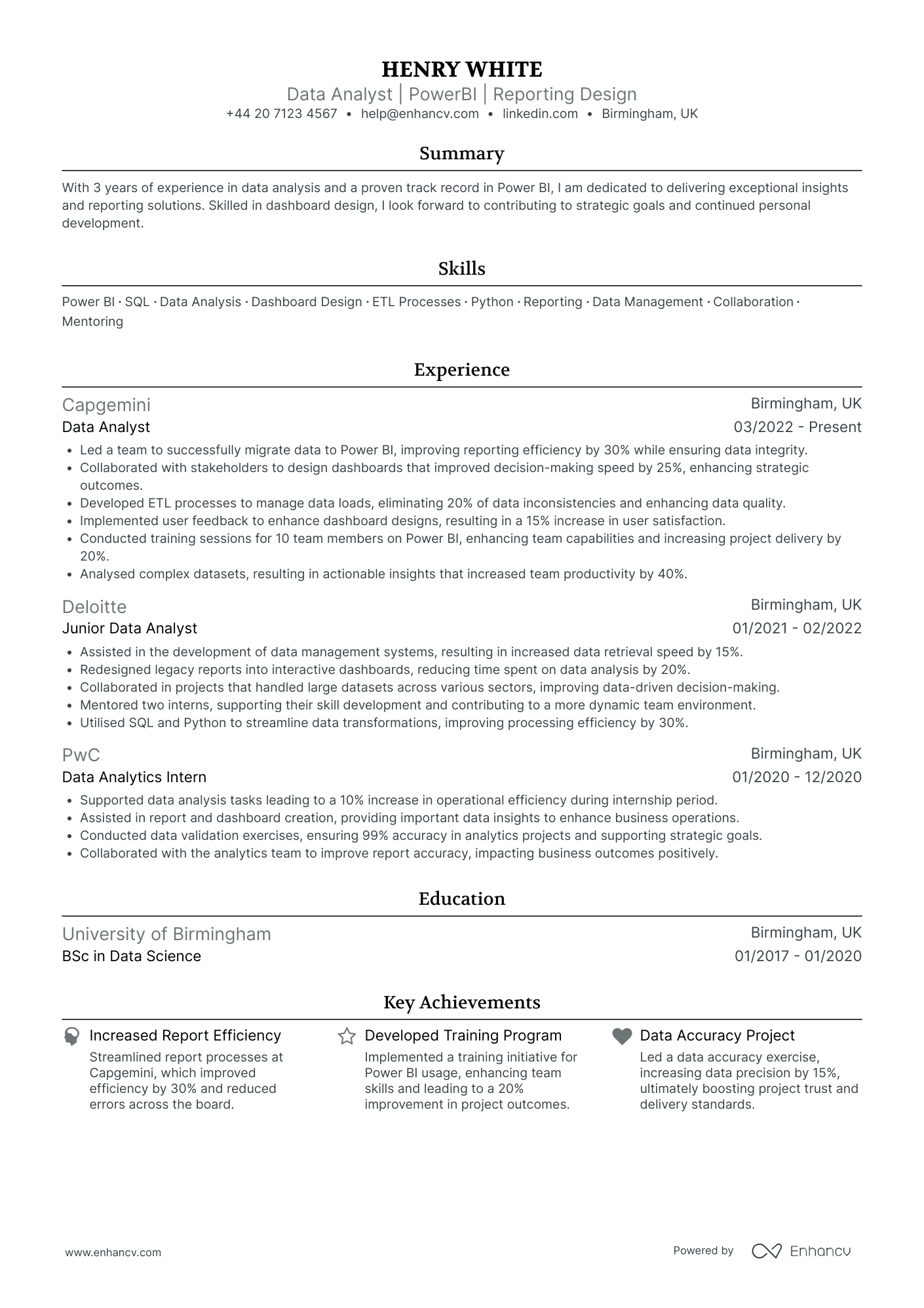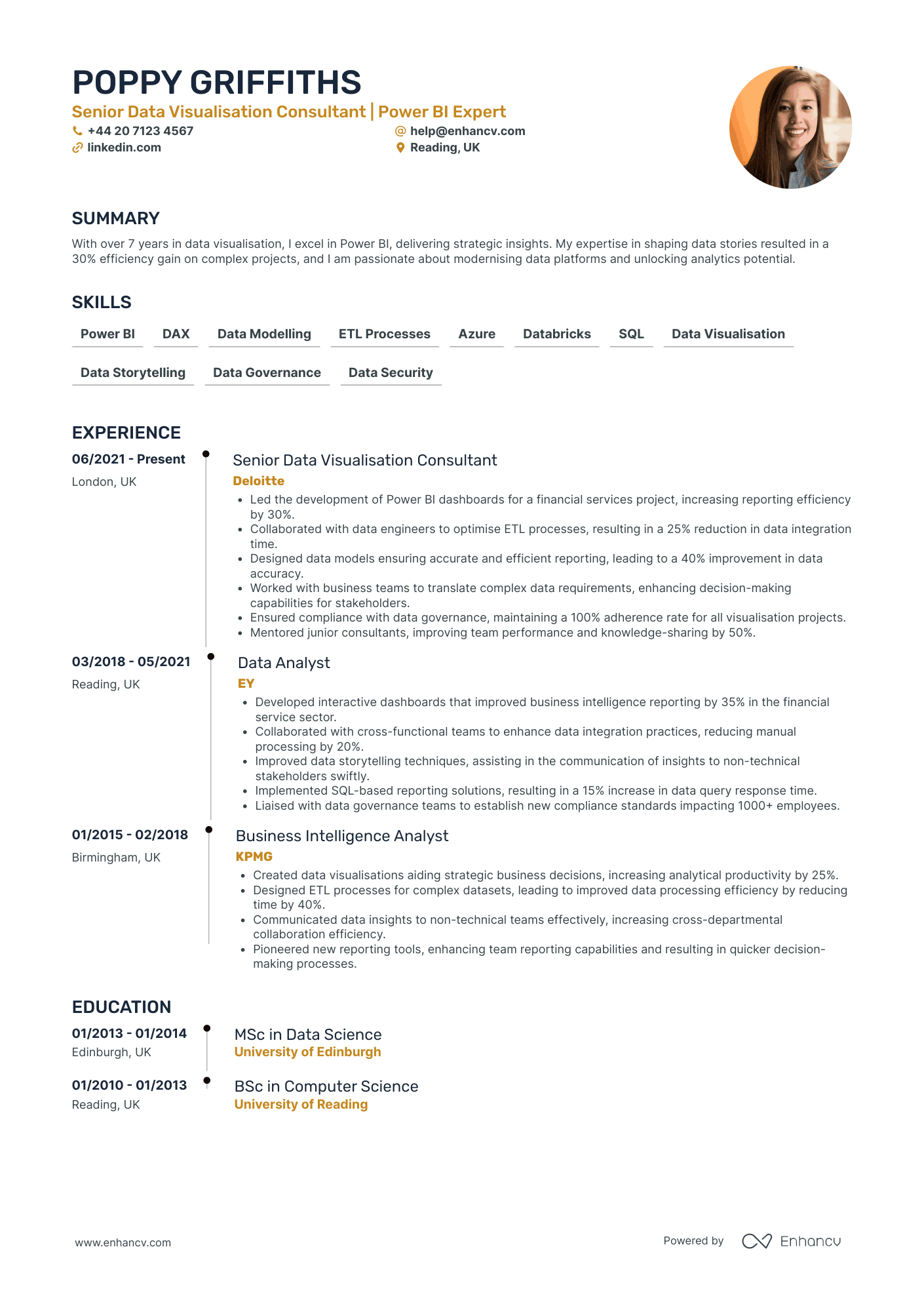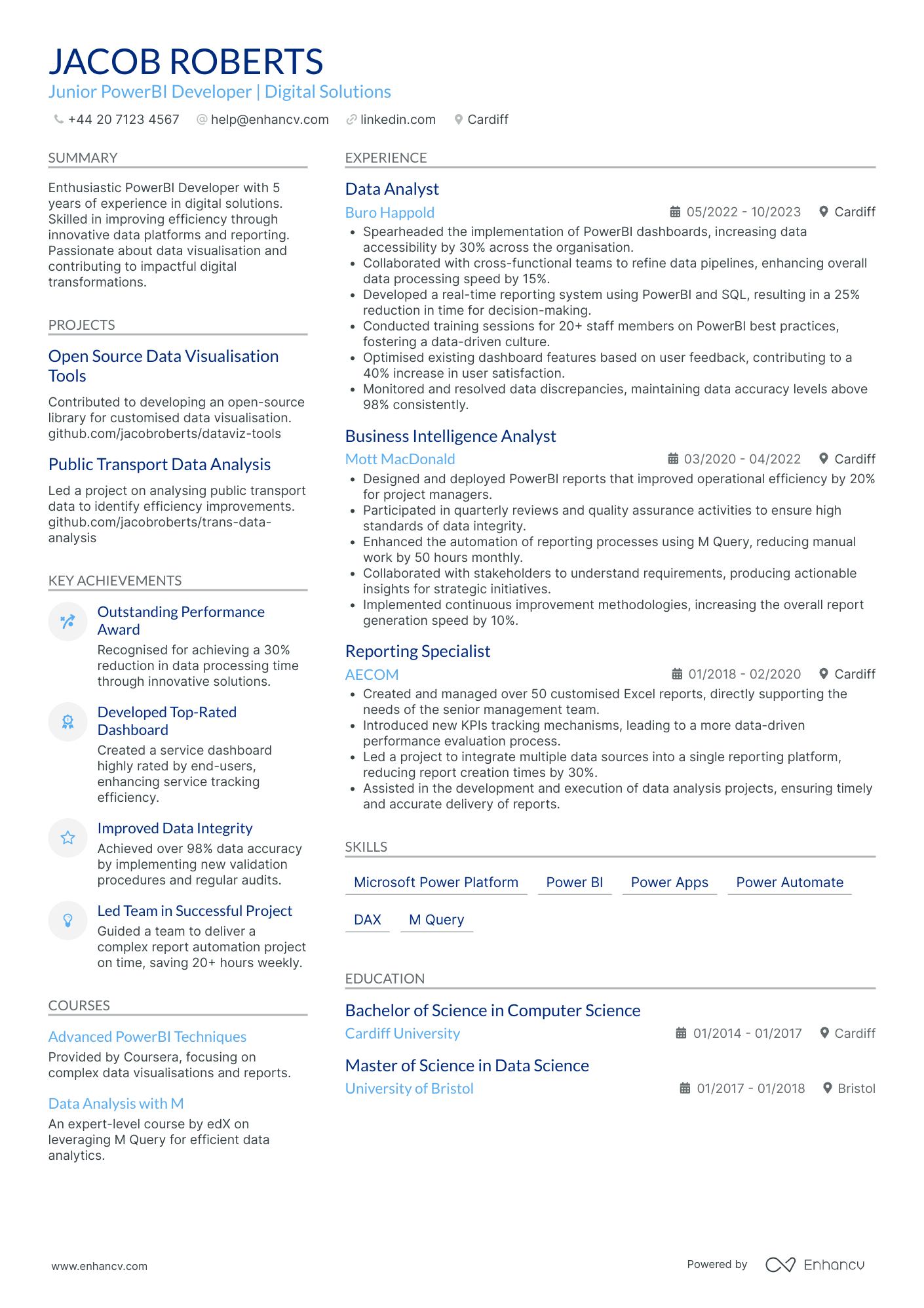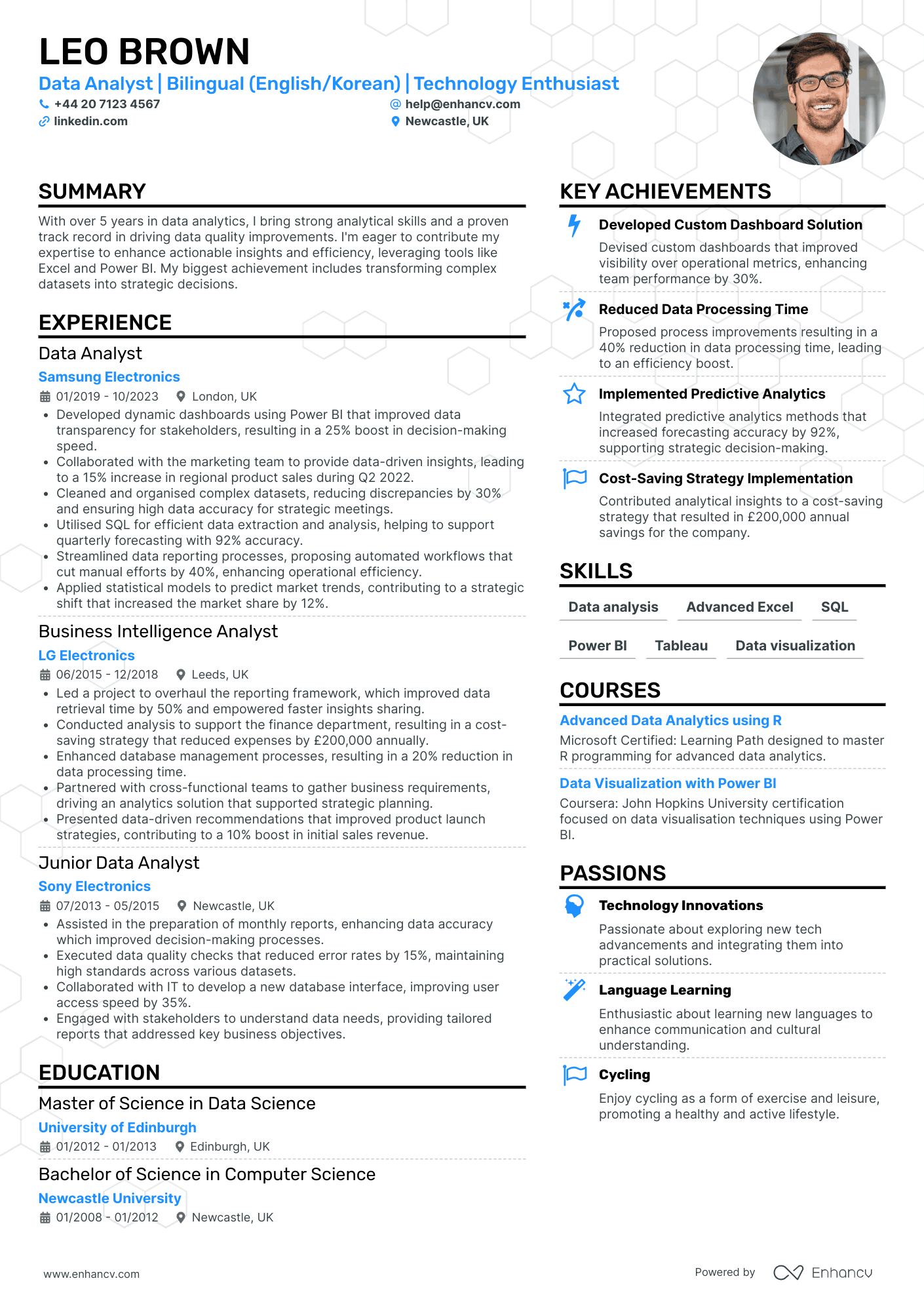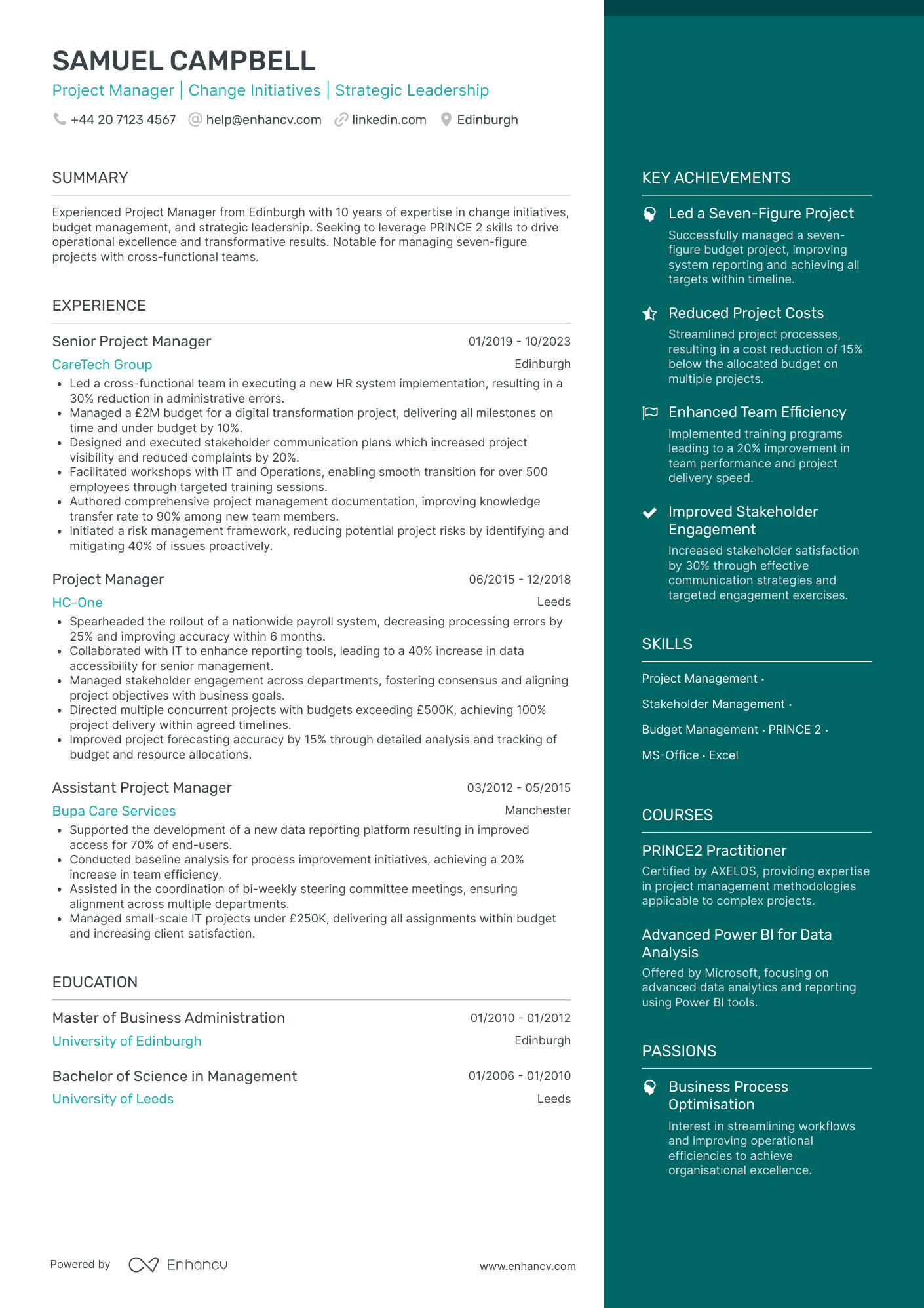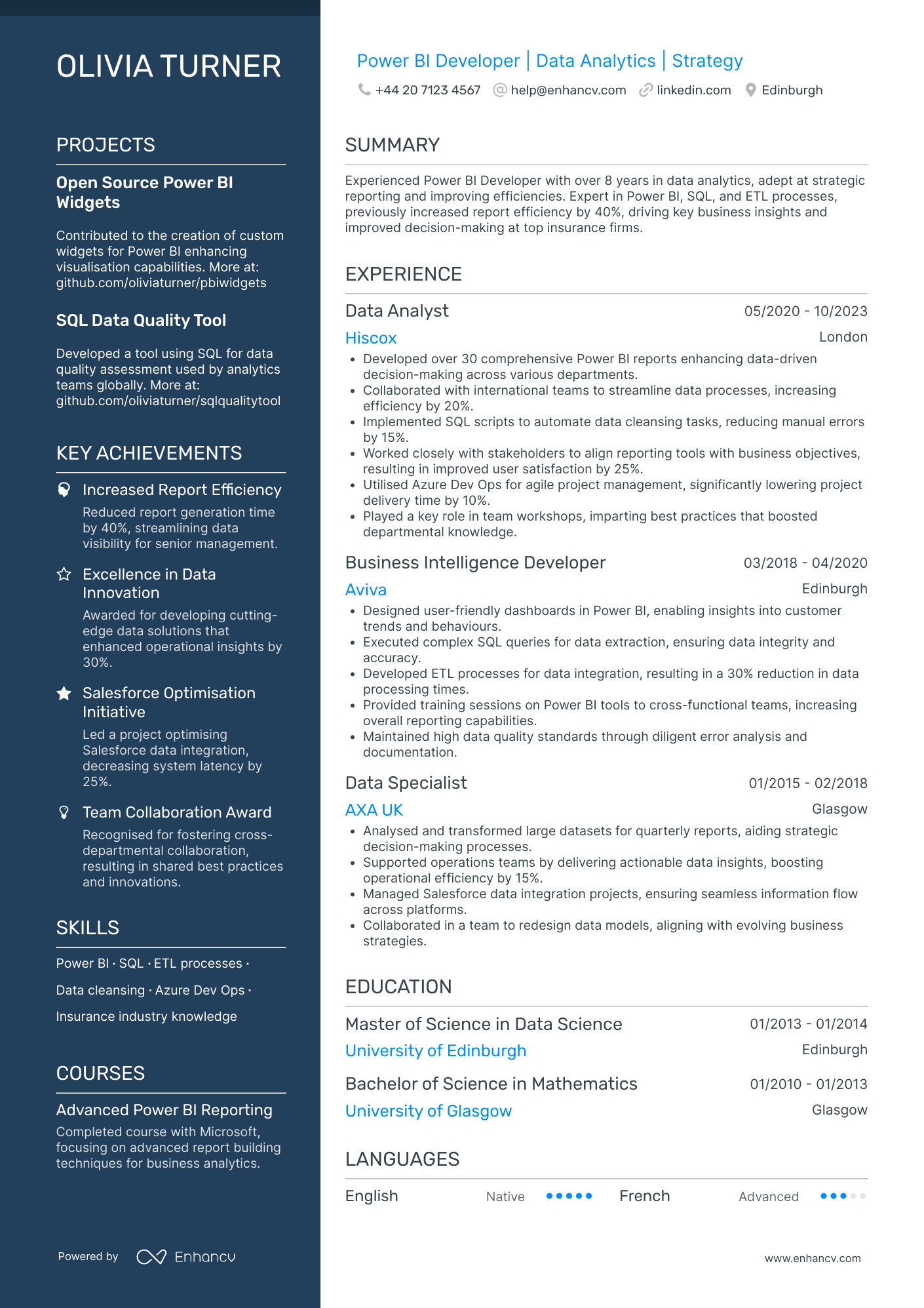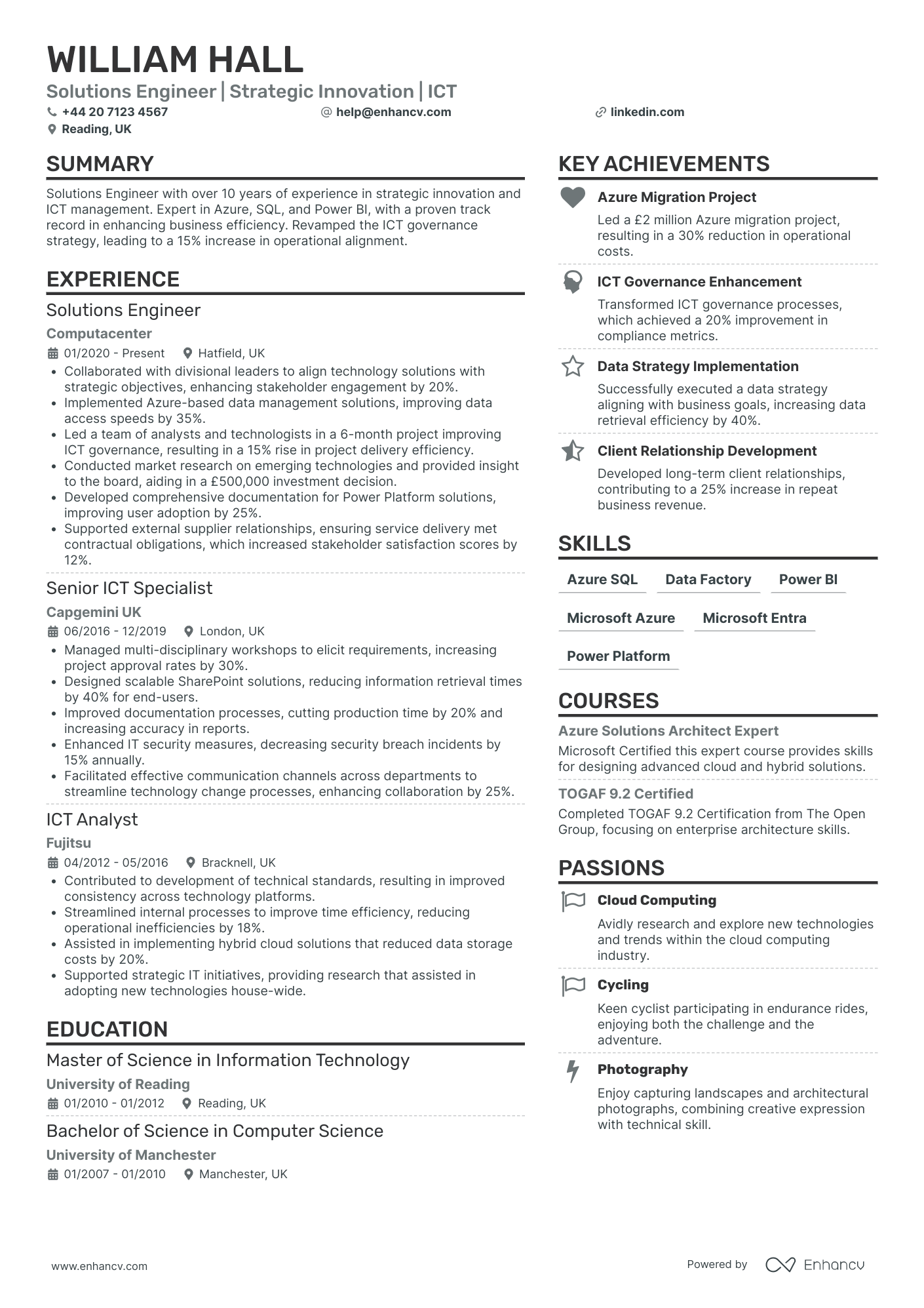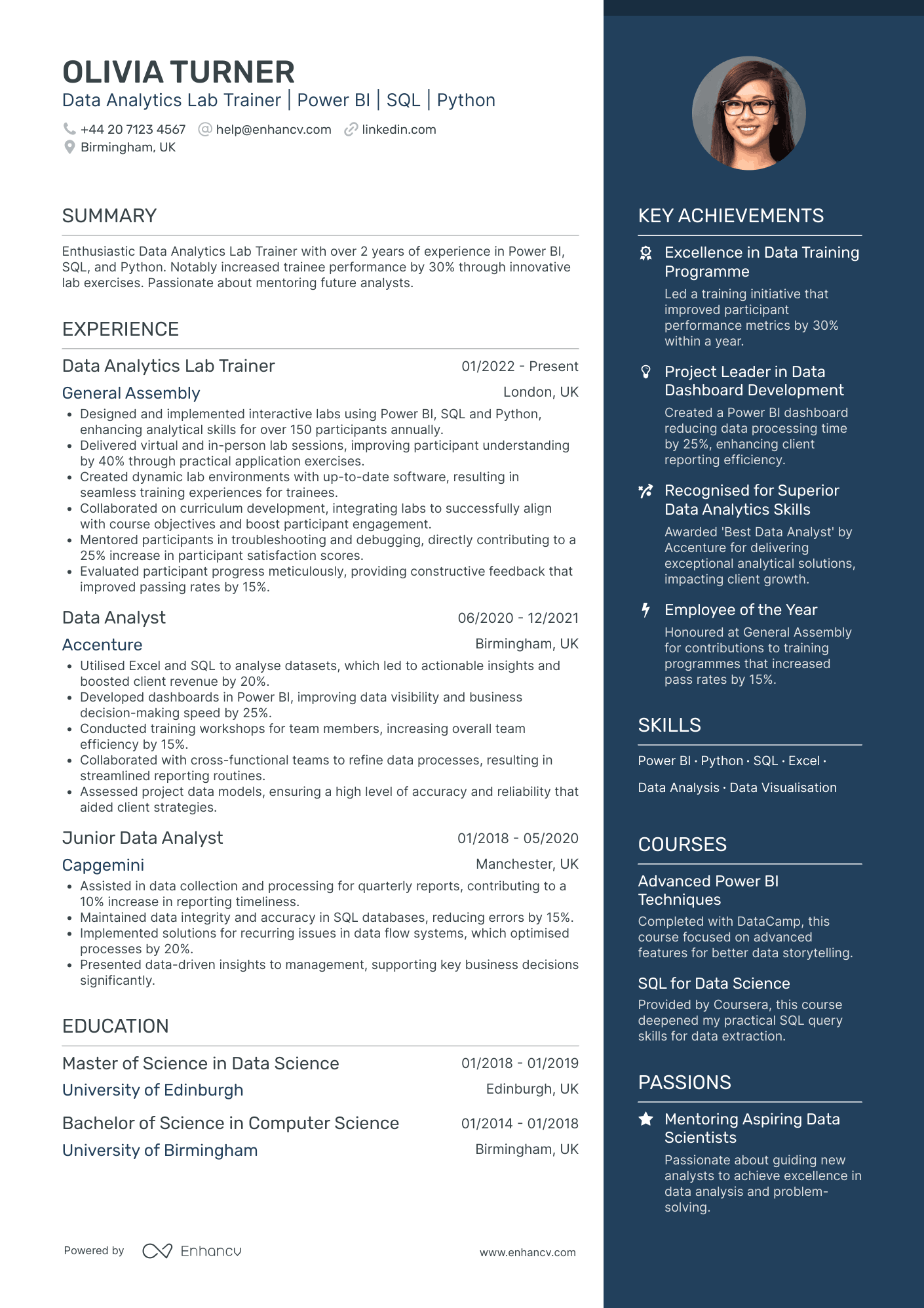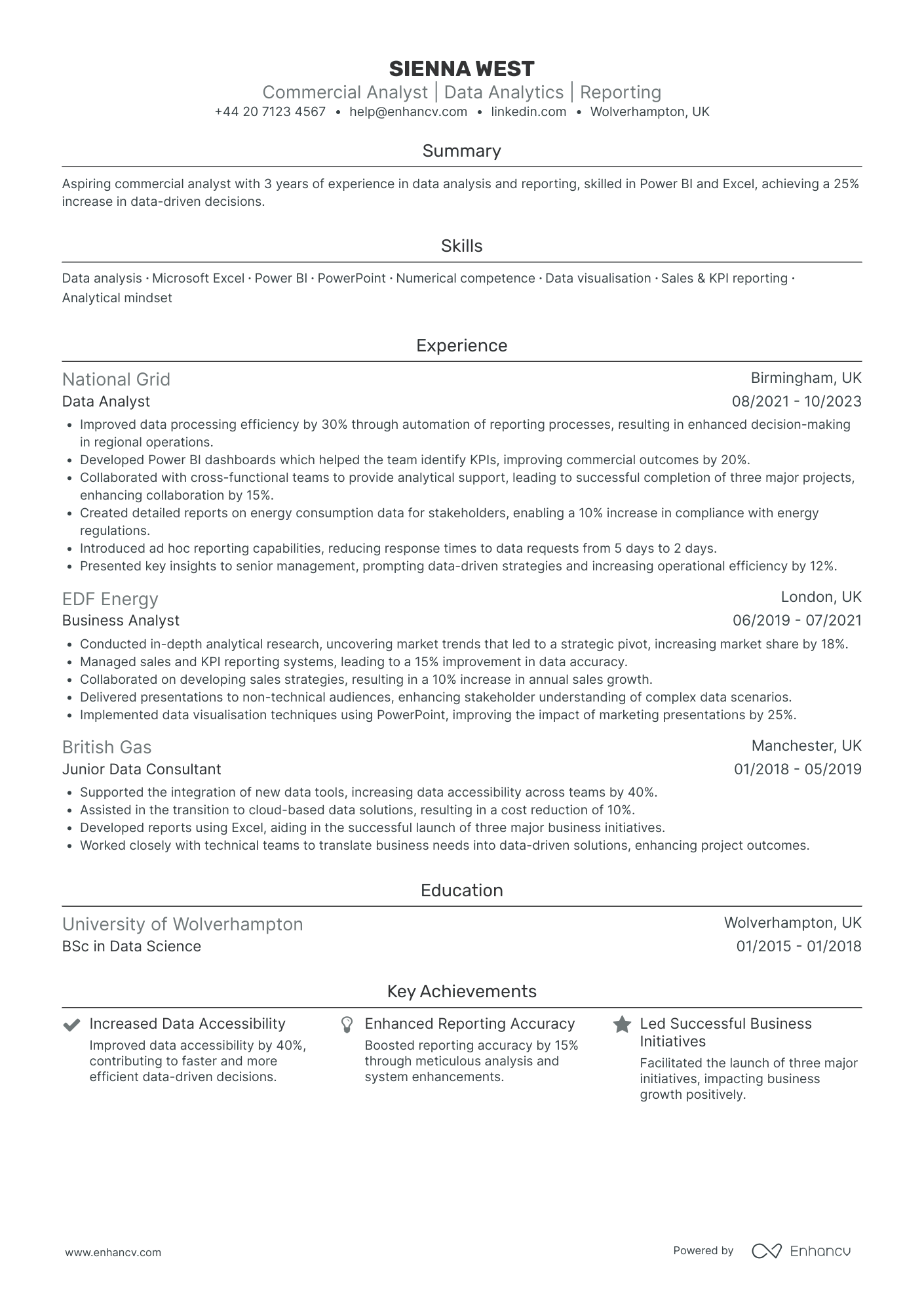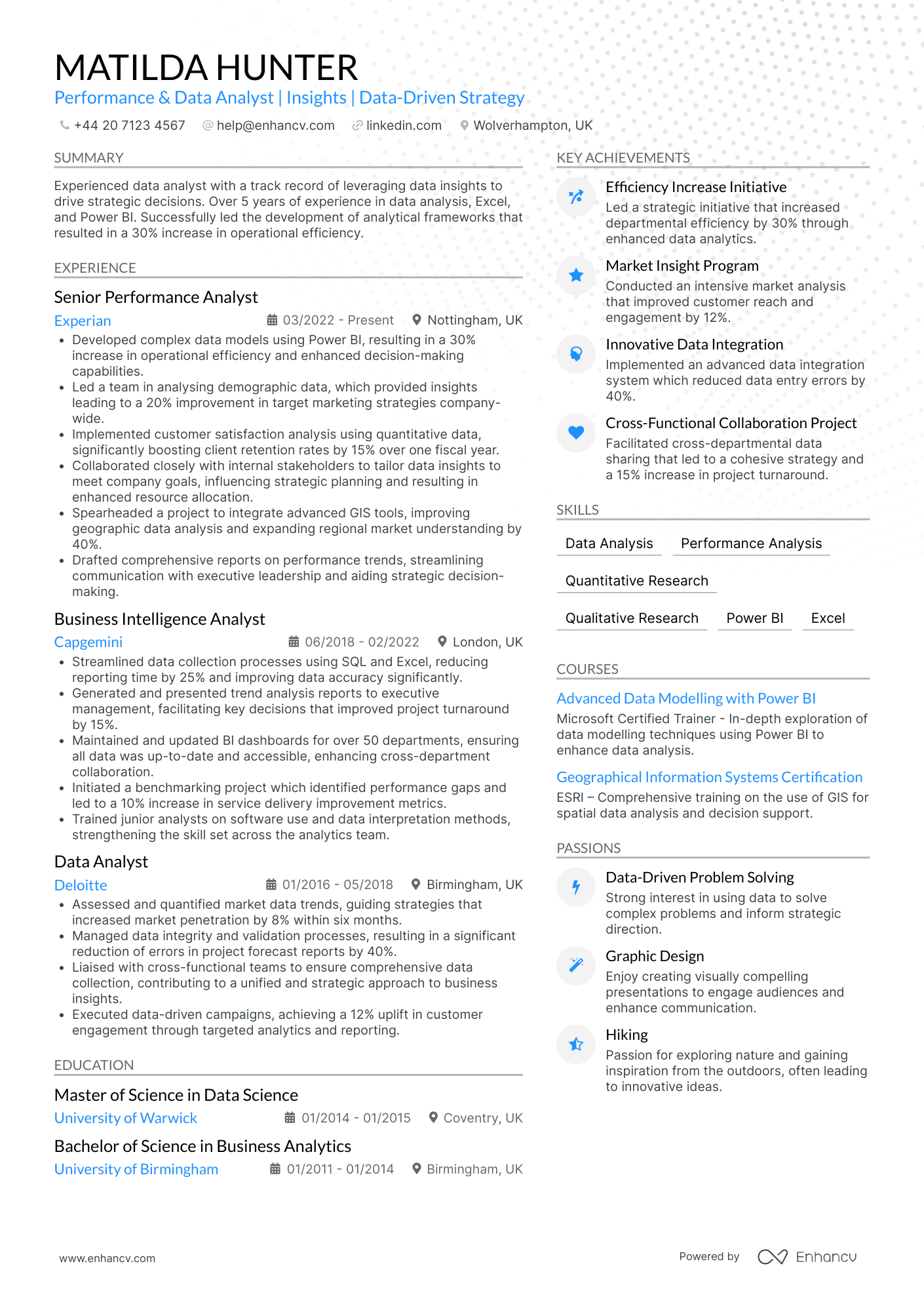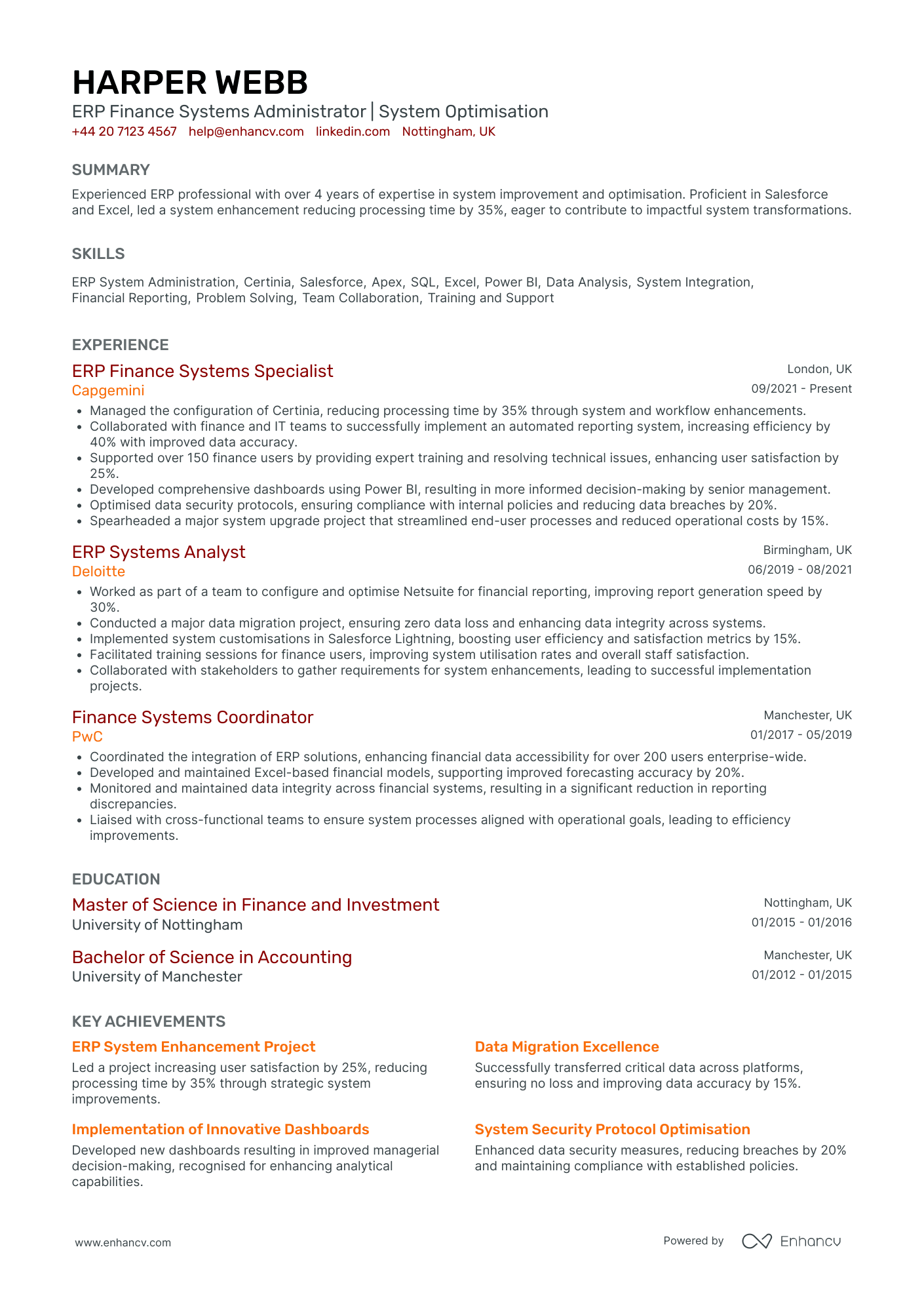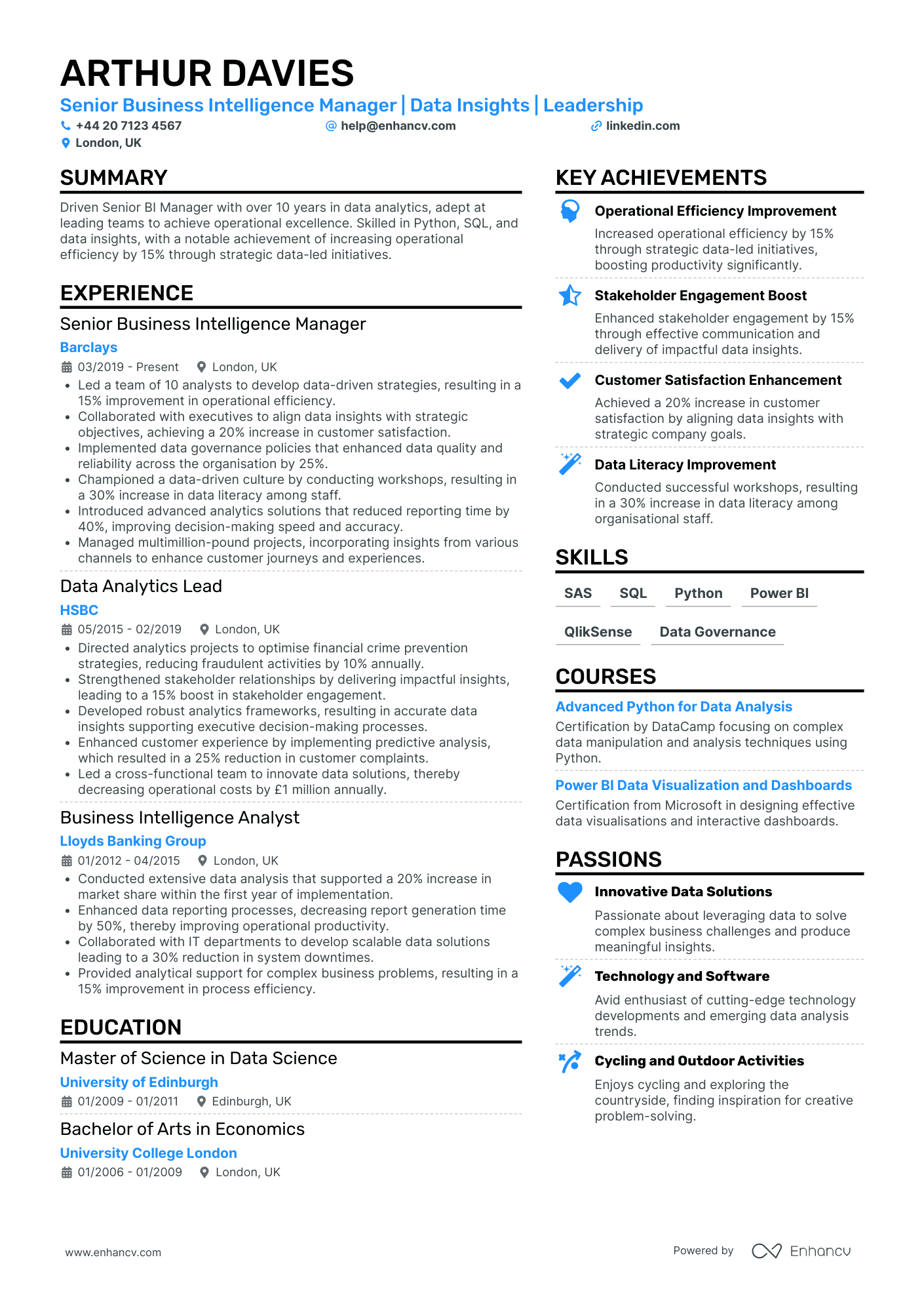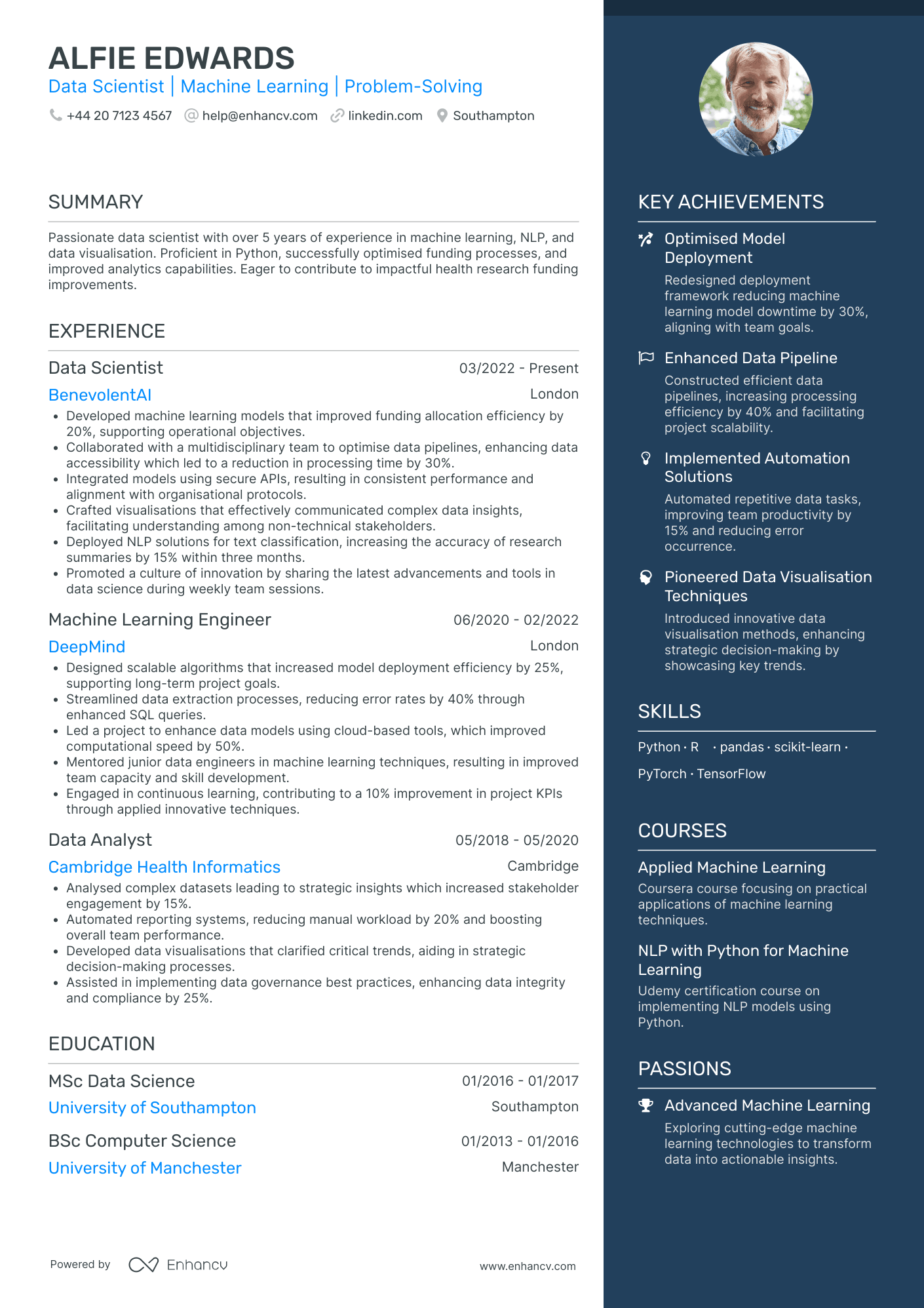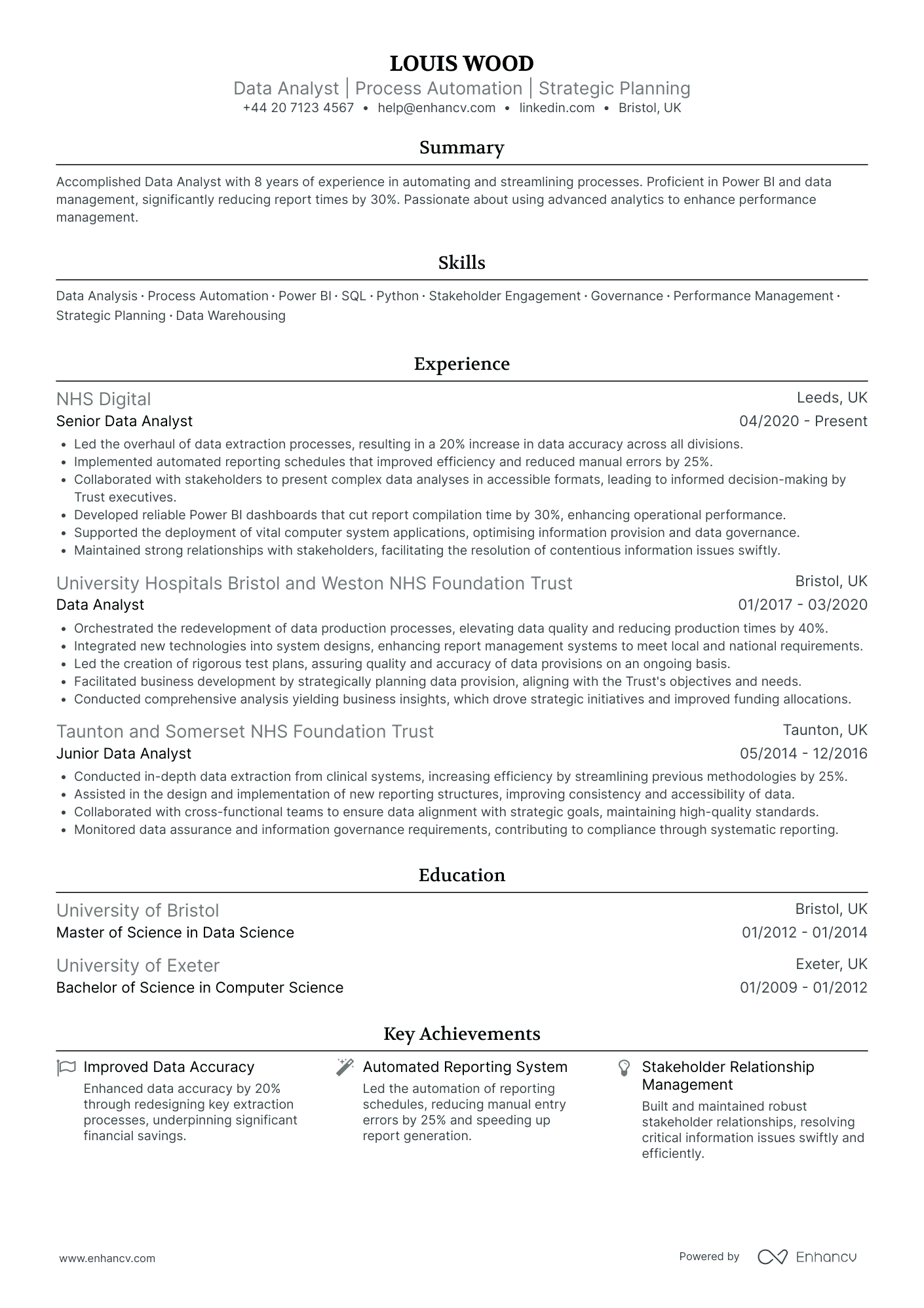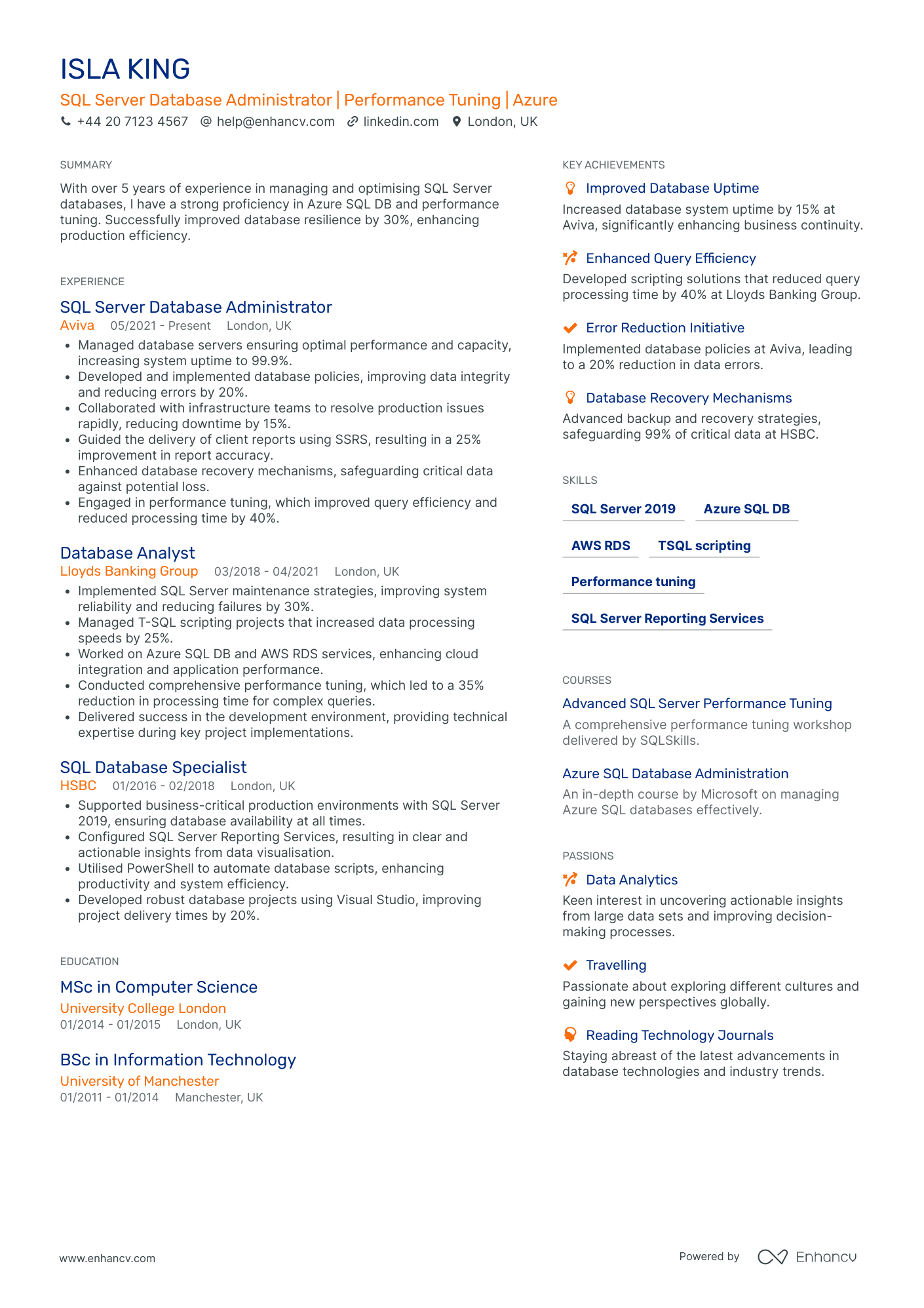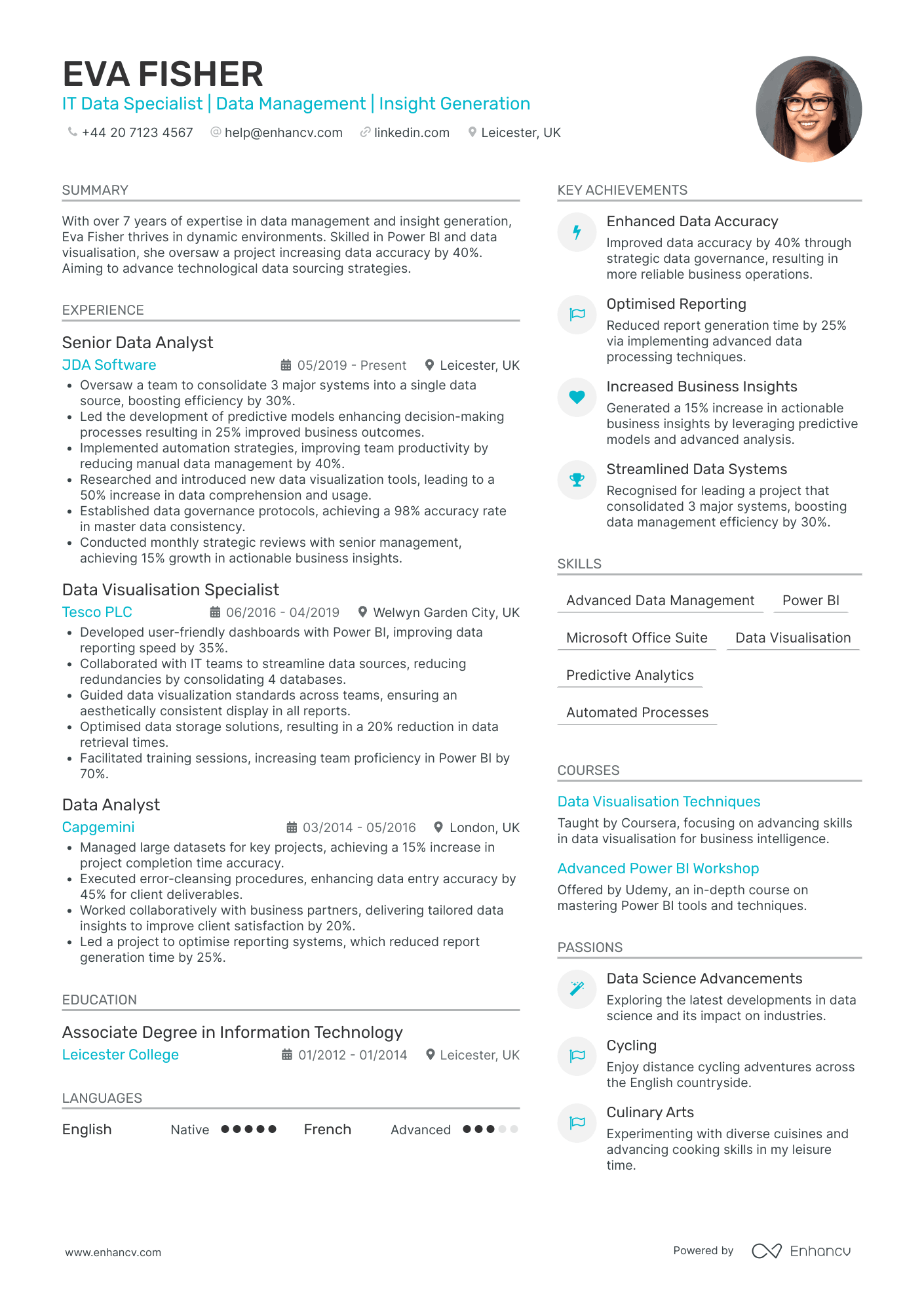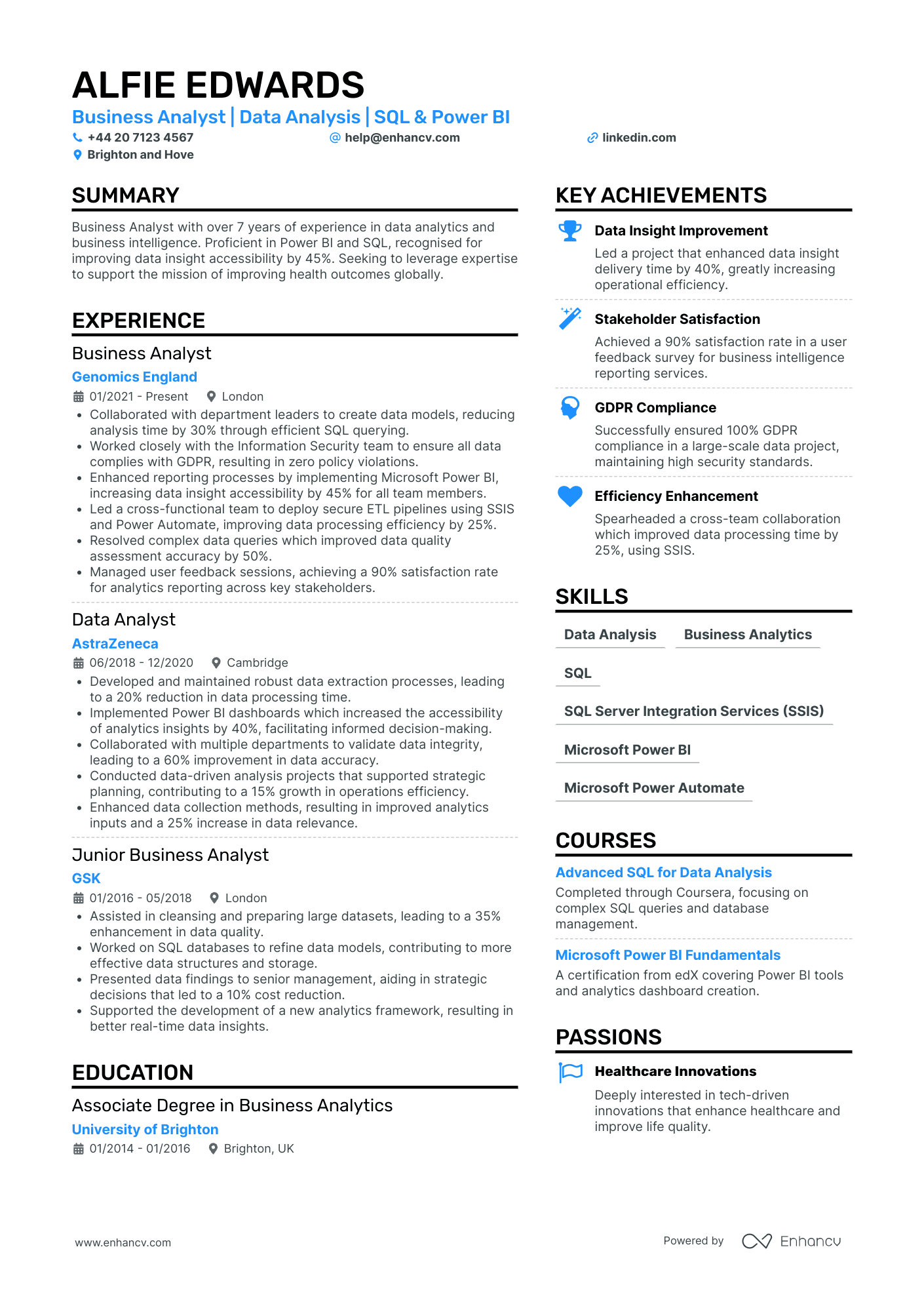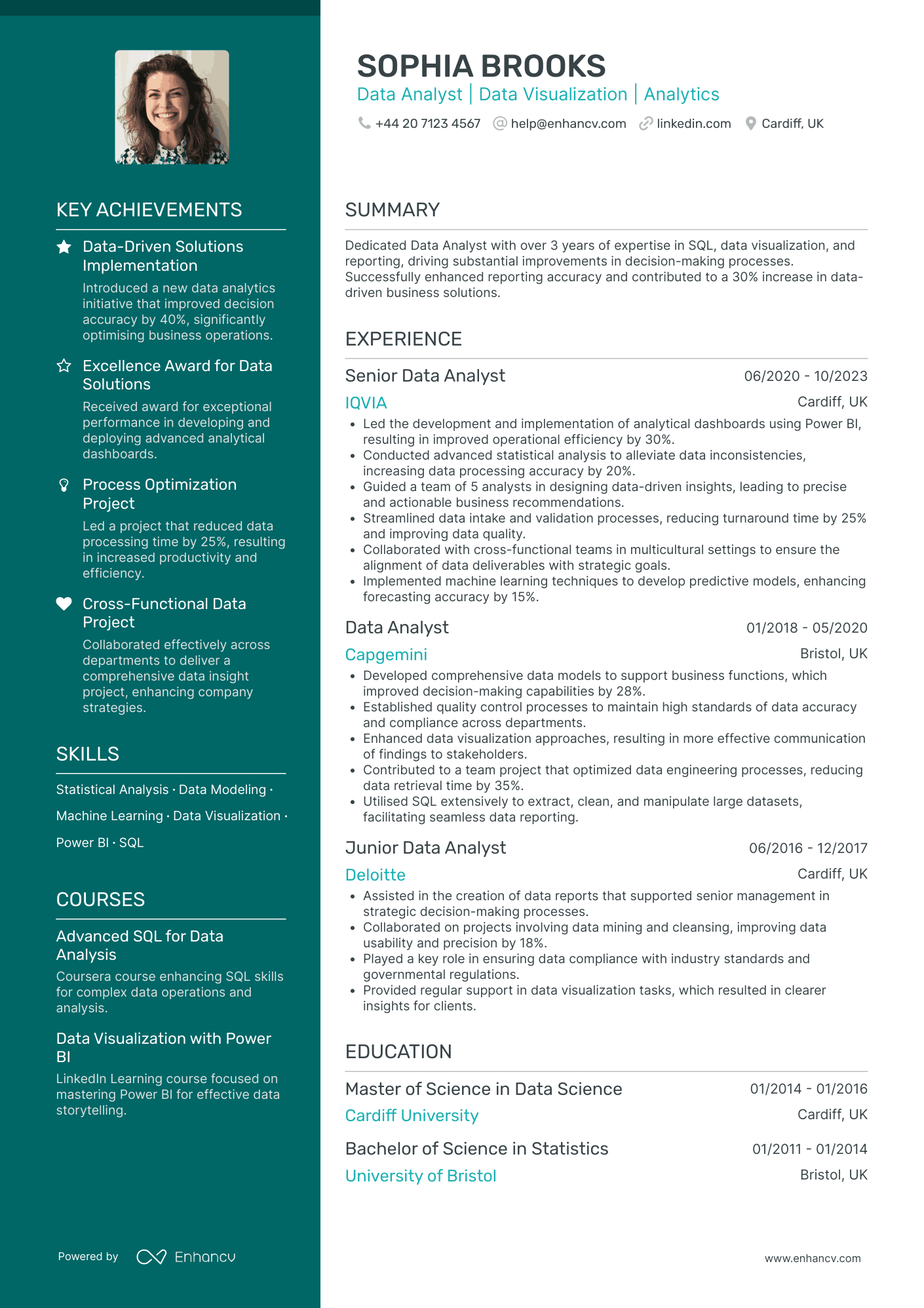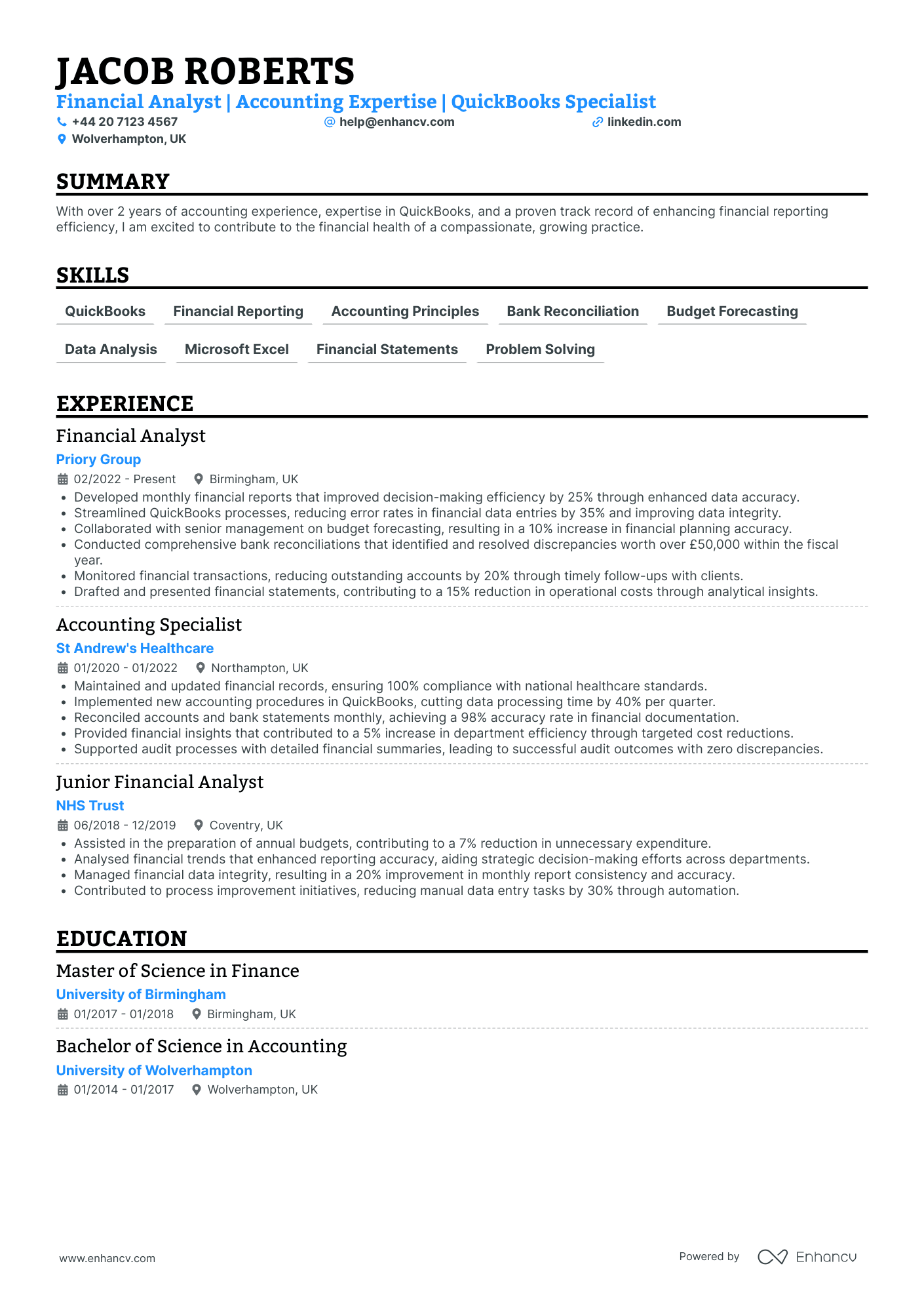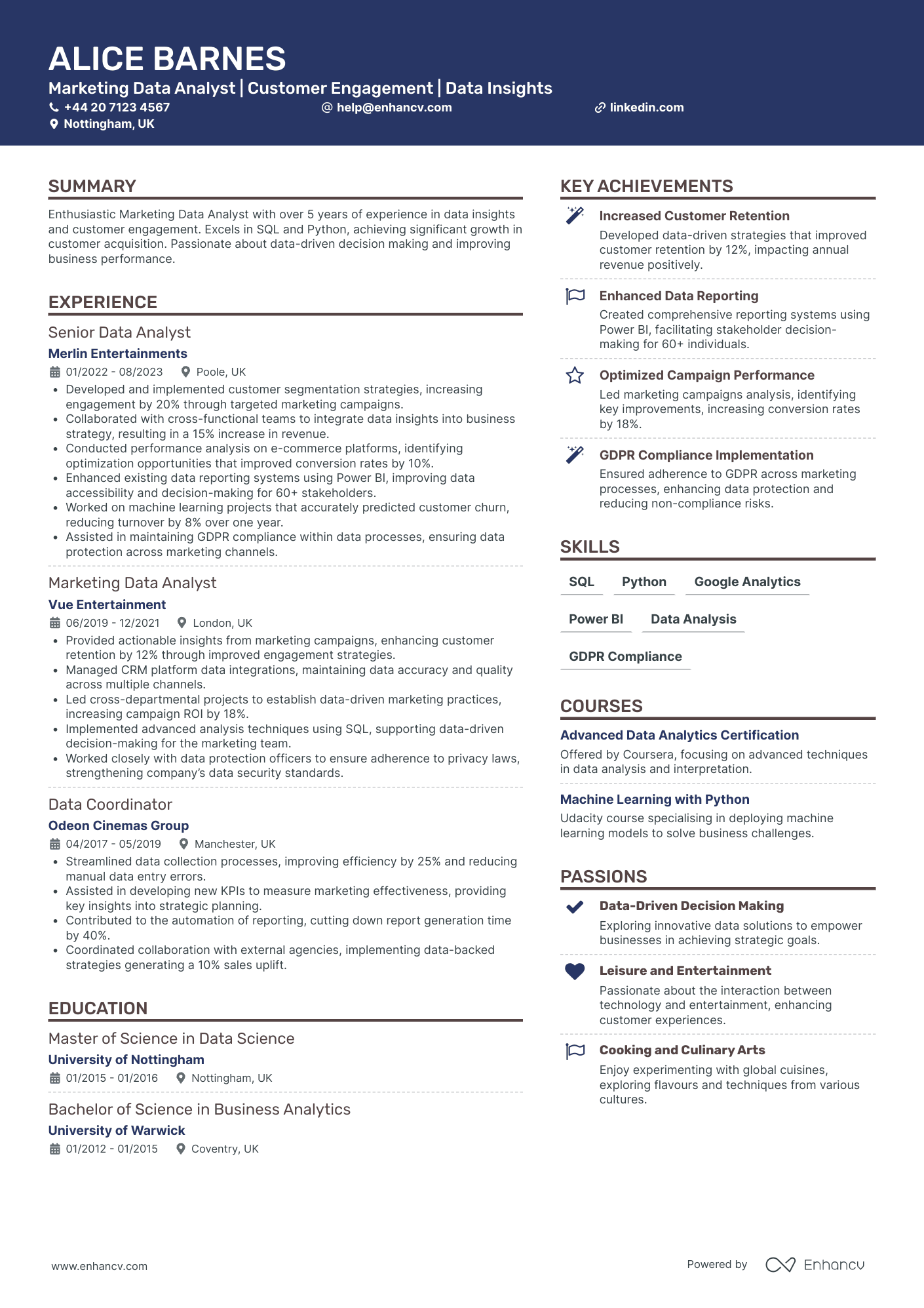Navigating through the diverse and complex visualisation options in Power BI can be a daunting challenge, especially when trying to effectively represent your data. Our detailed guide offers step-by-step instructions and expert tips to help you master visualisation choices that will make your data shine.
- Answer job requirements with your power bi CV and experience;
- Curate your academic background and certificates, following industry-leading CV examples;
- Select from +10 niche skills to match the ideal candidate profile
- Write a more succinct experience section that consists of all the right details.
Do you need more specific insights into writing your power bi CV? Our guides focus on unique insights for each individual role:
CV examples for power bi
By Experience
Junior Power Bi Developer
- Structured Evolution in Roles - The CV portrays a clear career trajectory from an intern to a Data Analyst, demonstrating growth and specialization in data-centric roles within top-tier consulting firms. Each role builds upon the experience gained in previous positions, showing a logical progression and commitment to the field of data analysis.
- Integration of Technical Depth and Leadership - The document details a unique blend of technical expertise in Power BI, SQL, and Python alongside leadership capabilities, such as mentoring interns and leading training sessions. This dual focus on technical depth and soft skills highlights the candidate’s value to teams needing both analytical insights and collaborative leadership.
- Achievements with Measurable Business Impact - Each achievement listed is not only quantifiable but also tied to broader business objectives, such as improving report efficiency by 30% and enhancing team productivity by 40%. These accomplishments directly relate to the candidate’s roles, reinforcing their ability to generate significant value for employers.
Senior Power Bi Consultant
- Comprehensive Career Progression - Poppy Griffiths' CV showcases a robust and steady career trajectory, highlighted by significant roles at prestigious firms such as Deloitte, EY, and KPMG. Her advancement from positions like Business Intelligence Analyst to Senior Data Visualisation Consultant underscores her growth and expertise within the data visualisation sector.
- Technical Mastery in Data Tools - The CV stands out in its demonstration of Poppy's deep technical proficiency with specific tools and methodologies pertinent to the data field. Skills in Power BI, DAX, and Azure, alongside her achievements in optimising ETL processes, illustrate her capability to handle complex data tasks and implement cutting-edge solutions effectively.
- Impactful Leadership and Mentoring - Leadership qualities are clearly highlighted through her role in mentoring junior consultants and improving team performance by 50%. This emphasis on leadership, coupled with strategic initiatives like leading a Power BI project, positions Poppy as not just a technical expert but also a proactive team leader driving significant business improvements.
Entry-Level Power Bi Developer
- Structured Experience Presentation - The CV presents work experience in a clear, concise format, with each role including bullet points that emphasize key contributions and the impact of the candidate’s work. This structured approach allows for easy comprehension of Jacob's career development and achievements.
- Progressive Career Path - Jacob’s career trajectory demonstrates clear progression from a Reporting Specialist to a Junior PowerBI Developer. This growth is indicative of increasing responsibility and expertise within data analytics, showcasing a commitment to advancing within the field.
- Specialization in PowerBI - The CV highlights a strong focus on PowerBI, a critical tool in data visualization and business intelligence. Jacob's expertise in PowerBI, demonstrated through projects, courses, and professional achievements, underscores his deep technical proficiency and relevance to the role of a PowerBI Developer.
By Role
Power Bi Data Analyst
- Effective content presentation - The CV is structured clearly and concisely, ensuring easy readability and quick comprehension. Each section is well defined and organized, helping to communicate qualifications efficiently. Bullet points are used effectively to list roles and achievements, making the document highly skimmable.
- Successful career trajectory - The candidate has shown a consistent upward career progression from a Junior Data Analyst to a more responsible Data Analyst role at Samsung Electronics. This progression, coupled with strategic geographical moves, illustrates growth and adaptability within the electronics and technology sectors.
- Proficiency with industry-specific tools - The CV emphasizes a strong command of data analysis tools like SQL, Power BI, and Excel, indicating deep technical expertise. The addition of certifications in Power BI and R further highlights a commitment to maintaining cutting-edge skills, which is critical in data-driven roles.
Power Bi Project Manager
- Comprehensive career development - Samuel Campbell's CV demonstrates a logical and impressive career trajectory, moving from an Assistant Project Manager to a Senior Project Manager within ten years. This progress highlights not only his capability for growth and increased responsibility but also his increasing influence in leading significant change initiatives and digital transformation projects.
- Strong focus on adaptability across industries - The CV reflects Samuel's ability to adapt to various roles and projects, showcasing cross-functional experience that includes managing HR system implementations and digital transformations. This versatility is essential for driving change in different organizational contexts, reaffirming his capacity to handle diverse challenges in project management.
- Effective use of project management methodologies - Samuel's expertise in project management is further illustrated by his proficiency in PRINCE 2 methodologies, critical for handling complex projects. His ability to manage stakeholder engagement and risk management tools ensures project outcomes are consistently delivered on time, within scope, and under budget, showcasing both his technical knowledge and strategic oversight.
Power Bi Report Developer
- Meticulous Content Presentation - Olivia Turner's CV demonstrates an impressive structure with clearly defined sections, allowing for quick comprehension. This clarity is enhanced by concise bullet points, making it easy for employers to identify key accomplishments at a glance.
- Rich Career Trajectory - The CV traces Olivia's growth from a Data Specialist to a Power BI Developer, reflecting a robust career advancement within the insurance and data analytics sectors. Each role shows increasing responsibility and complexity, highlighting her adaptability to evolving industry demands.
- Industry-Specific Technical Prowess - Olivia possesses a strong grasp of industry-specific tools like Power BI and Azure Dev Ops. This technical depth, combined with her expertise in SQL and ETL processes, is crucial for efficient data analysis and strategic reporting in insurance companies.
Power Bi Solutions Architect
- Structured clarity in presentation - The CV is structured with well-organized sections that allow easy navigation through the candidate's professional journey. Each segment is succinct yet comprehensive, providing a quick but detailed overview of skills and achievements, which is crucial for recruiters scanning numerous applications.
- Notable career growth and leadership evolution - The career trajectory demonstrates a clear upward progression from an ICT Analyst to a Solutions Engineer, reflecting the individual's ambition and capability to advance in their field. This progression is marked by increased responsibilities, showcasing leadership through team management and strategic decision-making.
- Technical expertise and industry relevance - The unique industry-specific elements are highlighted through the candidate's adept use of tools and technologies such as Azure, SQL, and Power BI. This technical depth is crucial for a Solutions Engineer role, ensuring they are equipped to handle the complexities of modern ICT environments.
Power Bi Trainer
- Structured and Clear Presentation - Olivia Turner's CV is well-structured, with sections clearly distinguishing between education, experience, and skills. Information is presented concisely, allowing a reader to quickly grasp her qualifications and career highlights, which is crucial for catching the attention of potential employers.
- Diverse Technical Expertise - The CV showcases Olivia’s proficiency in industry-relevant tools such as Power BI, SQL, and Python, emphasizing her technical depth. This is reinforced by her engagement in advanced courses, making her expertise particularly relevant for roles demanding data analytics and visualization capabilities.
- Dynamic Career Growth - Olivia’s career trajectory illustrates significant progression, moving from a Junior Data Analyst to a Data Analytics Lab Trainer. This indicates her expanding responsibilities and expertise over time, signaling a clear upward momentum within the analytics domain.
Power Bi Sales Specialist
- Effective Content Presentation - The CV is structured with clarity and conciseness, beginning with a focused summary that encapsulates Sienna West's key strengths and career highlights. Each section is well-organized, making it easy to read and ensuring that relevant information is accessible at a glance. This clear presentation underlines the candidate's communication skills and attention to detail.
- Career Growth and Industry Expertise - Sienna's career trajectory demonstrates significant growth and expertise in the energy sector, progressively advancing from a Junior Data Consultant to a Data Analyst, illustrating her commitment to professional development. The progression across reputable companies such as National Grid, EDF Energy, and British Gas showcases her ability to adapt and excel in varied organizational environments.
- Technical Proficiency and Methodological Depth - A strong focus on industry-specific tools such as Power BI, Excel, and other data visualization techniques highlights Sienna's technical proficiency. Her ability to use these tools to automate processes and develop impactful dashboards reflects a deep understanding of data analytics and its applications in enhancing business decisions and strategic outcomes.
Power Bi Quality Assurance Analyst
- Structured and Targeted Presentation - The CV stands out due to its clear and logical structure, presenting key information in a concise manner that effectively conveys Matilda Hunter's qualifications and career achievements. Each section is well-organized and neatly highlights important skills and experiences, ensuring that potential employers can quickly identify her strengths as a data analyst.
- Progressive Career Growth - Matilda's career trajectory showcases significant growth, evidenced by her progression from a Data Analyst at Deloitte to a Senior Performance Analyst at Experian. This upward movement highlights not only her expertise in data analytics but also her capacity to adapt and take on leadership roles, demonstrating both professional development and an ability to meet the demands of increasingly responsible positions.
- Industry-Specific Technical Expertise - The CV emphasizes Matilda's proficiency with various industry-specific tools and methodologies, such as Power BI, SQL, and GIS tools. Her ability to develop complex data models and integrate advanced GIS technologies indicates a high level of technical depth that is essential for driving data-driven strategy and insights in today's competitive market.
Power Bi Systems Administrator
- Clear and Structured Presentation - The CV is organized with clarity and a logical flow, starting from personal details to career experiences, education, skills, courses, and achievements. Each section is concise yet packed with relevant information, allowing for easy navigation and comprehension by potential employers.
- Demonstrated Career Trajectory and Growth - Harper Webb's CV reflects a steady progression in the ERP and finance systems domain, moving from a Finance Systems Coordinator at PwC to an ERP Finance Systems Specialist at Capgemini. This trajectory demonstrates both vertical career growth within roles and horizontal growth by taking on more complex responsibilities and projects over time.
- Technical Depth and System Optimization Expertise - The CV highlights Harper's proficiency with industry-specific tools such as Certinia, Salesforce, Apex, and SQL. It showcases the ability to lead projects that significantly optimize processing times and enhance data security, which are crucial skills in ERP system administration and financial reporting.
Power Bi Business Intelligence Manager
- Well-defined career progression - Arthur Davies' CV demonstrates a clear and logical career trajectory, advancing from a Business Intelligence Analyst to a Senior Business Intelligence Manager. Each role builds upon the previous experience, showcasing continuous growth in responsibilities and leadership capacities, reflecting a solid and strategic climb in the field of data analytics.
- Emphasis on cross-functional and leadership skills - The CV highlights Arthur's ability to lead diverse teams and work across various departments, essential for a Senior Business Intelligence Manager. His success in conducting workshops, aligning objectives with executive strategies, and improving stakeholder engagement signifies superior leadership and communication capabilities.
- Demonstrated technical expertise and innovation - Arthur’s proficiency in advanced data analytics tools like Python, SQL, and Power BI, along with his implementation of data governance policies and advanced analytics solutions, indicates a strong technical depth. His capacity to enhance data quality and speed decision-making processes exemplifies his ability to leverage technology for strategic business outcomes.
Power Bi Data Scientist
- Effective Structuring and Clarity - The CV is organized in a highly functional layout, ensuring clarity and easy navigation through sections such as experience, education, and skills. Each section is concise yet detailed, allowing quick identification of key qualifications and accomplishments without overwhelming the reader.
- Demonstrated Career Progression - Alfie's career trajectory shows a clear growth from a Data Analyst to a Data Scientist, highlighting strategic skill enhancements and a move towards more specialized roles in machine learning and data science. This illustrates ambition and a well-planned career path within the tech and healthcare industries.
- Adaptability Across Diverse Tools and Technologies - The CV highlights Alfie's ability to work with a wide range of industry-specific tools and methodologies, such as Python, TensorFlow, SQL, and AWS, which are critical for the roles undertaken. This range of expertise showcases adaptability and depth in technical knowledge, making him suitable for dynamic project environments.
Power Bi Data Engineer
- Content presentation and clarity - The CV presents information in a structured and concise manner, making it easy for readers to absorb key details quickly. Each section is clearly defined, and bullet points succinctly convey achievements and responsibilities, demonstrating a strong command of data-driven accomplishments.
- Career trajectory showcasing growth - Louis Wood's career path reflects progressive growth within the healthcare sector, evolving from a Junior Data Analyst to a Senior Data Analyst position. This progression is indicative of not only increased responsibilities but also trust in his ability to lead strategic data initiatives.
- Use of advanced tools and methodologies - The CV emphasizes the candidate's proficiency with industry-specific tools such as Power BI and SQL. This technical depth, combined with expertise in process automation, highlights a unique capability to implement cutting-edge analytical techniques that drive efficiency.
Power Bi Database Administrator
- Structured Layout and Clarity - The CV is well-organized, with clear sections that make it easy to navigate. Each section is concise, providing just enough information to convey the candidate's skills, experience, and achievements without overwhelming the reader.
- Career Progression and Industry Engagement - Isla King's career trajectory shows a clear progression, with advancements from SQL Database Specialist to DBA roles at prestigious companies. This journey highlights a deepening expertise in database management and performance tuning, with an evident commitment to staying ahead in the fast-evolving tech industry.
- Technical Proficiency in Advanced Database Tools - The CV showcases Isla's competence in specific tools and technologies crucial to the database management sector, such as SQL Server 2019, Azure SQL DB, and AWS RDS. This technical depth is further enhanced by her knowledge of performance tuning, showcasing her capability to innovate and optimize database performance.
Power Bi IT Support Specialist
- Content Presentation Ensures Clarity and Impact - The CV is well-structured, with clearly delineated sections that facilitate easy navigation, from the introductory summary to detailed experience descriptions. Each experience bullet point is concise yet informative, highlighting impactful achievements and responsibilities which paint a vivid picture of the candidate's skills and contributions.
- Demonstrates Progressive Career Trajectory - Eva Fisher's career path illustrates a clear progression from Data Analyst to Senior Data Analyst, showcasing growth and adaptation within increasingly complex roles. This reflects her capacity to take on more responsibility and her proficiency in managing larger projects and teams, emphasizing her leadership potential and capability within the IT data management space.
- Utilizes Cutting-Edge Tools and Methodologies - The CV highlights Eva's proficiency with industry-critical tools like Power BI, as well as advanced methodologies such as predictive analytics and data governance. These specifics demonstrate her technical depth and her commitment to employing sophisticated tools to enhance data accuracy, visualization, and decision-making processes in her roles.
Power Bi Integration Specialist
- Strong career progression - Alfie Edwards' CV demonstrates a steady and intentional career trajectory from a Junior Business Analyst to a prominent Business Analyst role. This progression reflects a commitment to personal and professional growth, underscored by a consistent focus on improving data processes and team outcomes.
- Proficiency in industry-specific tools - The CV highlights Alfie's expertise in key analytics and business intelligence tools such as SQL, Power BI, and SSIS. These technical proficiencies are underscored by coursework and certifications, indicating a deep technical depth that is crucial for data-driven decision making in the industry.
- Impact through achievements - Alfie's CV effectively showcases the real-world business impact of his contributions, such as reducing data processing time by 25% and increasing data insight accessibility by 45%. These achievements highlight his ability to drive efficiency and enhance data utilization, which are vital for business analysis roles.
Power Bi Healthcare Analyst
- Structured Career Growth - Sophia Brooks' CV outlines a clear career trajectory from a Junior Data Analyst to a Senior Data Analyst within reputable firms. This progression highlights her continuous professional development and increasing responsibilities, evidenced by her leadership role at IQVIA where she led a team of analysts.
- Technical Proficiency and Tool Mastery - The CV demonstrates Sophia's command over vital data analytics tools, including Power BI, SQL, and machine learning techniques. Her ability to leverage these tools for creating predictive models and enhancing reporting accuracy showcases her technical depth and relevance in the data analytics industry.
- Impactful Achievements with Business Relevance - The accomplishments detailed in Sophia's CV are not just about improving percentages but emphasize significant business impacts. For instance, the development of analytical dashboards led to a 30% increase in operational efficiency, underscoring her ability to translate data insights into strategic business solutions.
Power Bi Financial Analyst
- Clarity and Structured Presentation - The CV is presented in a well-organized format with clearly defined sections, making it easy to navigate. Key information such as education, professional experience, skills, and certifications are effectively separated, ensuring that the employer can quickly identify the candidate's qualifications and assess their suitability for the role.
- Career Progression and Growth - Jacob's career trajectory illustrates steady growth and increased responsibility, from a Junior Financial Analyst at NHS Trust to his current role as a Financial Analyst at Priory Group. This progression highlights his capability to take on more complex tasks and leadership roles, reflecting positively on his professional development within the accounting and finance sector.
- Industry-Specific Expertise and Tools - The CV effectively showcases Jacob’s deep industry knowledge, particularly his expertise in QuickBooks and financial modeling. Certifications such as the Certified QuickBooks ProAdvisor and FMVA add credibility to his technical skills, while achievements in streamlining processes and enhancing reporting efficiency demonstrate his practical application of these tools in real-world scenarios.
Power Bi Marketing Analyst
- Emphasizes Adaptability Through Diverse Roles - The CV demonstrates Alice Barnes's ability to adapt by detailing her growth from a Data Coordinator to a Senior Data Analyst across different entertainment companies. It showcases her capacity to handle increasing responsibilities and drive major projects, highlighting her readiness to tackle new challenges and environments.
- Utilizes Industry-Specific Tools and Techniques - Alice's expertise in tools like SQL, Python, Power BI, and CRM platforms is prominently featured. Her use of machine learning for customer churn prediction and data segmentation strategies underscores her technical acumen and her capability to harness advanced methodologies for real-world business applications.
- Highlights Effective Cross-Functional Collaboration - The CV effectively stresses her collaboration with cross-functional teams, illustrating how she integrates data insights into broader business strategies. This ability to liaise and work alongside different departments to achieve common goals speaks to her strong soft skills and her leadership in coalescing team efforts behind data-driven initiatives.
How complex should the format of your power bi CV be?
Perhaps, you decided to use a fancy font and plenty of colours to ensure your power bi CV stands out amongst the pile of other candidate profiles. Alas - this may confuse recruiters. By keeping your format simple and organising your information coherently, you'll ultimately make a better impression. What matters most is your experience, while your CV format should act as complementary thing by:
- Presenting the information in a reverse chronological order with the most recent of your jobs first. This is done so that your career history stays organised and is aligned to the role;
- Making it easy for recruiters to get in touch with you by including your contact details in the CV header. Regarding the design of your CV header, include plenty of white space and icons to draw attention to your information. If you're applying for roles in the UK, don't include a photo, as this is considered a bad practice;
- Organising your most important CV sections with consistent colours, plenty of white space, and appropriate margins (2.54 cm). Remember that your CV design should always aim at legibility and to spotlight your key information;
- Writing no more than two pages of your relevant experience. For candidates who are just starting out in the field, we recommend to have an one-page CV.
One more thing about your CV format - you may be worried if your double column CV is Applicant Tracker System (ATS) complaint. In our recent study, we discovered that both single and double-column CVs are ATS-friendly . Most ATSes out there can also read all serif and sans serif fonts. We suggest you go with modern, yet simple, fonts (e.g. Rubik, Lato, Raleway) instead of the classic Times New Roman. You'll want your application to stand out, and many candidates still go for the classics. Finally, you'll have to export your CV. If you're wondering if you should select Doc or PDF, we always advise going with PDF. Your CV in PDF will stay intact and opens easily on every OS, including Mac OS.

PRO TIP
For certain fields, consider including infographics or visual elements to represent skills or achievements, but ensure they are simple, professional, and enhance rather than clutter the information.

The top sections on a power bi CV
- Professional Summary to quickly highlight expertise: It sets the stage with a concise overview of your skills and experience specific to Power BI roles.
- Core Competencies focus on specific Power BI skills: This section showcases technical abilities and keywords that match job descriptions.
- Professional Experience featuring Power BI achievements: It illustrates your practical experience with Power BI through past job accomplishments.
- Education and Certifications for credibility: Includes formal background and any Power BI-related certifications to establish qualifications.
- Power BI Projects and Portfolio to show real-world use: Provides concrete examples of Power BI work and its impact on business outcomes.

What recruiters value on your CV:
- Highlight your proficiency with Power BI tools by detailing specific projects where you've transformed data into visual insights and interactive reports.
- Emphasise your experience with DAX, data modelling, and Power Query, as these skills are essential for creating complex reports and dashboards in Power BI.
- Demonstrate your understanding of various data sources and your ability to connect, import, and manipulate data within Power BI, which is crucial for data preparation and analysis.
- Include any certifications or courses completed that are relevant to Power BI, such as the Microsoft Certified: Data Analyst Associate, to establish credibility and show commitment to the role.
- Detail how you've used Power BI to drive business decisions, such as identifying trends or improving operational efficiencies, to show the practical impact of your BI initiatives.
Recommended reads:
How to present your contact details and job keywords in your power bi CV header
Located at the top of your power bi CV, the header presents recruiters with your key personal information, headline, and professional photo. When creating your CV header, include your:
- Contact details - avoid listing your work email or telephone number and, also, email addresses that sound unprofessional (e.g. koolKittyCat$3@gmail.com is definitely a big no);
- Headline - it should be relevant, concise, and specific to the role you're applying for, integrating keywords and action verbs;
- Photo - instead of including a photograph from your family reunion, select one that shows you in a more professional light. It's also good to note that in some countries (e.g. the UK and US), it's best to avoid photos on your CV as they may serve as bias.
What do other industry professionals include in their CV header? Make sure to check out the next bit of your guide to see real-life examples:

Examples of good CV headlines for power bi:
- Power BI Analyst | Data Visualisation Expert | Certified | 4+ Years' Experience in Market Analytics
- Senior BI Developer | ETL Solutions | Microsoft Power BI Certified | Strategic Insights | 10 Years
- Data Analyst | Power BI Pro | Specialising in Financial Reporting | 6 Years' Experience
- Lead Data Strategist | Power BI Master | BI Implementation | 8+ Years in Data Science
- Junior BI Consultant | Power BI Enthusiast | DAX & SQL Proficient | 2 Years' Professional Analysis
- Business Intelligence Manager | Expert in Power BI and Big Data | 12+ Years in BI Solutions
Opting between a power bi CV summary or objective
Within the top one third of your power bi CV, you have the opportunity to briefly summarise your best achievements or present your professional goals and dreams. Those two functions are met by either the CV summary or the objective.
- The summary is three-to-five sentences long and should narrate your best successes, while answering key requirements for the role. Select up to three skills which you can feature in your summary. Always aim to present what the actual outcomes were of using your particular skill set. The summary is an excellent choice for more experienced professionals.
- The objective is more focused on showcasing your unique value as a candidate and defining your dreams and ambitions. Think about highlighting how this current opportunity would answer your career vision. Also, about how you could help your potential employers grow. The objective matches the needs of less experienced candidates, who need to prove their skill set and, in particular, their soft skills.
Still not sure about how to write your CV opening statement? Use some best industry examples as inspiration:

CV summaries for a power bi job:
- With over five years of experience as a Data Analyst, adept in the creation of impactful Power BI dashboards and reports, I bring a proven track record of utilising key business metrics to drive strategic decisions and improve operational efficiency.
- Accomplished Financial Analyst transitioning into the Power BI sphere, armed with a strong foundation in data-driven financial modelling, passionate about leveraging business intelligence tools to transform raw data into actionable insights.
- As a seasoned Marketing Manager with ten years' tenure, I am now pivoting to focus on Power BI and data visualisation to bolster marketing strategies with solid data analytics, drawing from extensive experience in market analysis and campaign management.
- Dynamic professional capable of designing and deploying comprehensive Power BI solutions, with a flair for synthesising complex dataset into intuitive visualisations, boasting a consistent record of delivering projects that enhance data accessibility and decision-making.
- Eager to embark on a career in business intelligence and data analysis, seeking an entry-level opportunity to apply my recent certification in Power BI and commitment to lifelong learning to assist in delivering robust data-driven solutions.
- Aspiring Business Intelligence Analyst, possessing a strong analytical mindset and foundational knowledge in data management, eager to further develop Power BI skills through active engagement in challenging projects that drive business growth.
How to meet job requirements with your power bi CV experience
We've now reached the essence of your actual CV - your experience section. This is the space where you can list your career roles and on-the-job successes. Many candidates tend to underestimate just how much time and effort they should put into writing this CV section. Your experience shouldn't be a random list of your responsibilities, but instead:
- Match the job description with your skills, values, and accomplishments;
- Start each bullet with a strong action verb, followed up with one key skill and your outcome of applying this skill;
- Spotlight parts of your career history that are relevant to the job you're applying for.
Before we move on, make sure to check out some professional CV experience sections.

Best practices for your CV's work experience section
- Designed and developed interactive Power BI dashboards with drill-down capabilities to enable company-wide insights, leading to a 20% reduction in decision-making time.
- Conducted data modelling using DAX to create complex measures and calculated columns, enhancing report accuracy and supporting advanced analytics.
- Leveraged Power Query to extract, transform, and load data from diverse sources, including SQL databases, Excel, and cloud services, ensuring a seamless and automated data refresh process.
- Implemented row-level security on Power BI reports to ensure compliance with data governance policies and protect sensitive information.
- Worked closely with cross-functional teams to gather requirements and translate business needs into tangible Power BI visualisations, resulting in a 30% increase in user satisfaction.
- Optimised Power BI dashboards for mobile viewing, supporting remote and on-the-go access for a distributed workforce.
- Provided Power BI training and documentation for end-users, facilitating self-service BI and fostering a data-driven culture within the organisation.
- Collaborated with IT to manage Power BI Gateway for data refresh scheduling, maintaining real-time data flow and system integrity.
- Utilised Azure Analytics services in conjunction with Power BI to handle big data, perform advanced analytics, and drive predictive modelling initiatives.
- Spearheaded the development of interactive dashboards and reports resulting in a 30% reduction in decision-making time for senior management at a Fortune 500 company.
- Created a comprehensive data warehouse using SQL Server that consolidated data from various sources, improving data retrieval times by 50%.
- Implemented row-level security within Power BI reports, ensuring compliance with data governance policies and protecting sensitive information.
- Led a cross-functional team in the design and deployment of a Power BI solution that tracked KPIs across sales, finance, and operations for a large retail chain.
- Developed custom DAX measures and calculations to uncover hidden insights in financial data, contributing to a 15% increase in profitability.
- Facilitated Power BI training sessions for 100+ business users, enhancing the company's self-service analytics capabilities.
- Integrated Power BI with existing enterprise systems to automate the reporting processes, saving over 200 man-hours per month.
- Collaborated on the creation of an executive dashboard that presented key financial metrics, influencing a shift in investment strategy.
- Conducted a thorough analysis of production data which identified bottlenecks, leading to a 20% increase in manufacturing efficiency.
- Developed a forecasting model within Power BI for inventory management that decreased stock shortages by 35%.
- Optimized ETL processes to feed data models in Power BI and reduced report generation time by over 65%.
- Worked closely with IT to implement an automated data refresh solution that ensured reports reflected real-time data, thereby improving operational responsiveness.
- Assisted in the migration of legacy BI systems to Power BI, improving report accuracy and availability.
- Created visualizations to display market trends for the marketing department, which were used to adjust campaign strategies dynamically.
- Maintained Power BI service by setting up data gateways and monitored the service health, providing uninterrupted access to business-critical reports.
Lacking professional expertise: how to write your CV to highlight your best talents
Don't count on your lucky stars when you're applying for a role, where you happen to have less (or almost none) professional experience. Recruiters sometimes do hire inexperienced candidates if they're able to present their unique value from the get-go. So, instead of opting for the traditional, CV experience section:
- List any applicable expertise you happen to have - no matter if it's a part-time job, internship, or volunteer work. This would hint to recruiters that your profile is relevant;
- Focus your CV on your transferrable skills or talents you've obtained thanks to your whole life and work experience. In effect, you'll be spotlighting your value as a candidate;
- Separate more space for your applicable academic background and certificates to show you have the technical know-how;
- Ensure that within your objective, you've defined why you'll like the job and how you'll be the perfect match for it. Always ensure you've tailored your CV to individual applications.
Looking for more good examples for your first job? We'll show you how other candidates, with less professional experience, have created their job-winning CVs.
Recommended reads:

PRO TIP
Describe how each job helped you grow or learn something new, showing a continuous development path in your career.
The CV skills' divide: between hard and soft skills
Of course, you may have read the job requirements plenty of times now, but it's key to note that there is a difference between technical and personal skills. Both are equally relevant to your job application. When writing about your skill set, ensure you've copy-pasted the precise skill from the job requirement. This would not only help you ensure you have the correct spelling, but also pass any Applicant Tracker System (ATS) assessments.
- Hard skills show your technological capabilities. Or whether you'll be a good technical fit to the organisation. Ensure you've spotlighted your hard skills in various sections of your CV (e.g. skills section, projects, experience) by including the technology and what you've attained;
- Soft skills pinpoint your personality and people or communication skills, hinting at if you'll easily accomodate into the team or organisation. Quantify your soft skills in your CV achievements, strengths, summary/objective, and experience sections. Always support your soft skills with how they've helped you grow as a professional.
Top skills for your power bi CV:
Data Modelling
DAX (Data Analysis Expressions)
Power Query
Data Visualization
Microsoft Power BI Development
SQL
Data Analysis
Business Intelligence
Report Development
Data Integration
Analytical Thinking
Problem-Solving
Attention to Detail
Communication
Time Management
Project Management
Teamwork
Adaptability
Creativity
Continuous Learning

PRO TIP
Use mini case studies or success stories in your CV to demonstrate how your skills have positively impacted previous roles or projects.
Your university degree and certificates: an integral part of your power bi CV
Let's take you back to your uni days and decide what information will be relevant for your power bi CV. Once more, when discussing your higher education, select only information that is pertinent to the job (e.g. degrees and projects in the same industry, etc.). Ultimately, you should:
- List only your higher education degrees, alongside start and graduation dates, and the university name;
- Include that you obtained a first degree for diplomas that are relevant to the role, and you believe will impress recruiters;
- Showcase relevant coursework, projects, or publications, if you happen to have less experience or will need to fill in gaps in your professional history.

PRO TIP
Focus on describing skills in the context of the outcomes they’ve helped you achieve, linking them directly to tangible results or successes in your career.
Recommended reads:
Key takeaways
Write your professional power bi CV by studying and understanding what the role expectations are. You should next:
- Focus on tailoring your content to answer specific requirements by integrating advert keywords through various CV sections;
- Balance your technical know-how with your personal skills to showcase what the unique value would be of working with you;
- Ensure your CV grammar and spelling (especially of your key information and contact details) is correct;
- Write a CV summary, if your experience is relevant, and an objective, if your career ambitions are more impressive;
- Use active language by including strong, action verbs across your experience, summary/objective, achievements sections.
